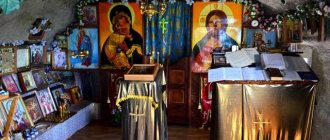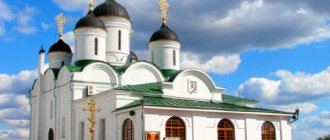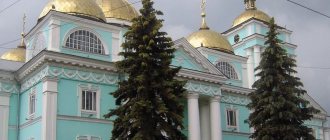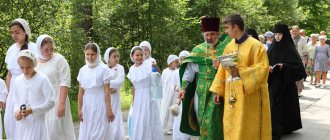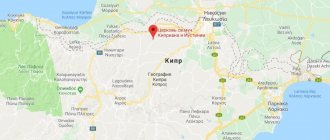Mir
Russia Vladimir Region Murom Annunciation Monastery (Murom) Map loading in progress...
{"format":"leaflet","minzoom":false,"maxzoom":false,"limit":50,"offset":0,"link":"all","sort":[""], "order":[],"headers":"show","mainlabel":"","intro":"","outro":"","searchlabel":"\u2026 \u0441\u043b\u0435\ u0434\u0443\u044e\u0449\u0438\u0435 \u0440\u0435\u0437\u0443\u043b\u044c\u0442\u0430\u0442\u044b","default":"","import-annotation":false,"width ":"auto","height":"350px","centre":{"text":"","title":"""link":"""lat":55.58233299999999843521436559967696666717529296875,"lon": 42.05477799999999888314050622284412384033203125,"icon":""},"title":"","label":"","icon":"","lines":[],"polygons":[], "circles":[ ],"rectangles":[],"copycoords":false,"static":false,"zoom":8,"defzoom":14,"layers":["OpenStreetMap"],"image layers":[] ,"overlays":[],"resizable":false,"fullscreen":true,"scrollwheelzoom":true,"cluster":false,"clustermaxzoom":9,"clusterzoomonclick":true,"clustermaxradius":80, "clusterspiderfy":true,"geojson":"","clicktarget":"","showtitle":true,"hidenamespace":false,"template":"","userparam":"","activeicon": "","pagelabel":false,"ajaxcoordproperty":"","ajaxquery":"","locations":[{"text":"\u003Cb\u003E\u003Ca href=\"/palomnik/%D0% 91%D0%BB%D0%B0%D0%B3%D0%BE%D0%B2%D0%B5%D1%89%D0%B5%D0%BD%D1%81%D0%BA%D0%B8% D0%B9_%D0%BC%D1%83%D0%B6%D1%81%D0%BA%D0%BE%D0%B9_%D0%BC%D0%BE%D0%BD%D0%B0%D1% 81%D1%82%D1%8B%D1%80%D1%8C_(%D0%9C%D1%83%D1%80%D0%BE%D0%BC)\» title=\»\u0411\u043b\ u0430\u0433\u043e\u0432\u0435\u0449\u0435\u043d\u0441\u043a\u0438\u0439 \u043c\u0443\u0436\u0441\u043a\u043e\u0439 \u043c\u0 43e\u043d\u0430\u0441\u0442\ u044b\u0440\u044c (\u041c\u0443\u0440\u043e\u043c)\»\u003E\u0411\u043b\u0430\u0433\u043e\u0432\u0435\u0449\u0435\u043d\u0441\ u043a\u0438\u0439\ u043c\u0443\u0436\u0441\u043a\u043e\u0439 \u043c\u043e\u043d\u0430\u0441\u0442\u044b\u0440\u044c (\u041c\u0443\u0440\u043e\u0 43c)\u003C/a\u003E\ u003C/b\u003E\u003Chr /\u003E\u003Ca href=\"/palomnik/%D0%A1%D0%B2%D0%BE%D0%B9%D1%81%D1%82%D0%B2%D0% BE:%D0%90%D0%BD%D0%BD%D0%BE%D1%82%D0%B0%D1%86%D0%B8%D1%8F\» title=\»\u0421\u0432\u043e \u0439\u0441\u0442\u0432\u043e:\u0410\u043d\u043d\u043e\u0442\u0430\u0446\u0438\u044f\»\u003E\u0410\u043d\u043d\u043e\u0442 \u0430\u0446\u0438\ u044f\u003C/a\u003E: »'\u041c\u0443\u0440\u043e\u043c\u0441\u043a\u0438\u0439 \u043c\u0443\u0436\u0441\u043a\u043e\u0439 \u0 411\u043b\u0430\u0433 " e\u0441\u043d\u043e\u0432 IV 13\u0440\u043e\u0437\u043d\u044b \u043c. \u041f\u043e \u043f\u0440\u0435\u0434\u0430\u043d\u0438\u044e \u0440\u0430\u0441\u043f\u043e\u043b\u043e\u0436\u0435\u043d \u043d\u0430 \u043c\u0435\u0441 \u0442\u0435 \u0434\u0435\u0440\u0435\u0432\u044f\u043d\u043d\u043e\u0439 \u0446\u0435\u0440\u043a\u0432\u0438 \u043f\u04 40\u0438\u0434\u0432\u043e \u0440\u0435\" \u043a\u043d\u044f\u0437\u044f \u041a\u043e\u043d\u0441\u0442\u0430\u043d\u0442\u0438\u043d\u0430, \u043a\u0 440\u0435\u0441\u0442\ u0438\u0432\u0448\u0435\u0433\u043e \u041c\u0443\u0440\u043e\u043c.","title":"\u0411\u043b\u0430\u0433\u043e\u0432\u0435\u0449\u0 435\u043d\ u0441\u043a\u0438\u0439 \u043c\u0443\u0436\u0441\u043a\u043e\u0439 \u043c\u043e\u043d\u0430\u0441\u0442\u044b\u0440\u044c (\u 041c\u0443\u0440\u043e\u043c )","link":"","lat":55.58233299999999843521436559967696666717529296875,"lon":42.05477799999999888314050622284412384033203125,"icon":""} ],"imageLayers":[]}
55.583515; 42.056202
Russia, Vladimir region, Murom, Timiryazeva street
Murom, Vladimir region
Russia
Telephone.:
+7(49234)2-05-02
Murom Monastery of the Annunciation
founded in 1553 by Tsar Ivan IV the Terrible. According to legend, it is located on the site of a wooden church “at the court” of Prince Constantine, who baptized Murom.
History[edit]
The Murom Annunciation Monastery arose from the modest wooden Church of the Annunciation of the Blessed Virgin Mary. Church tradition attributes its construction to St. bl. Prince Konstantin (Yaroslav) Svyatoslavich.
According to church legend, the inhabitants of Murom for a long time professed a pagan religion that deified the forces of nature. Having heard about this, Prince Konstantin begged Murom from his father as his inheritance in order to convert the inhabitants of the city to the Christian faith. His sons Mikhail and Fedor helped him in this godly work. The Murom pagans, not wanting to accept the prince, killed his youngest son Mikhail. Struck by a miraculous sign from the icon of the Mother of God, later called Murom, they repented of their crime and were baptized in the waters of Lake Kstovo, located not far from the city.
Soon, on the “Old High Fortified Settlement”, fortified with a tine and earthen ramparts, the first Murom church was erected in honor of the Annunciation of the Blessed Virgin Mary. A princely palace was erected nearby. The body of the murdered Prince Mikhail was laid at the temple. Gradually, the entire princely family found peace near the walls of the Annunciation Church. In 1547, on the basis of local veneration, the church-wide canonization of the blessed Prince Constantine and his children Mikhail and Fedor was carried out.
The monastery was founded on the site of the Annunciation Church according to the vow of Tsar Ivan the Terrible. He visited Murom in 1552 during a campaign against Kazan, fervently prayed to the new miracle workers for victory, and promised, if successful, to establish a monastic monastery. After the capture of Kazan, a team of architects arrived in Murom. During the construction of the stone temple, tombs with the relics of the princes were found, which were solemnly placed in the new Annunciation Cathedral with prayer singing.
The Annunciation Monastery enjoyed the highest favors. The tsar sent all the necessary utensils for church needs, gave the brethren “inexhaustible alms” and land holdings, which expanded in the 17th century.
In 1616, the monastery was ravaged by the Poles, plundering many relics granted by Ivan the Terrible. New “sovereign alms” helped restore the monastery. The cathedral was rebuilt again. In 1652, the chapel of St. John the Evangelist was added to it. At the end of the 17th century, a high tented bell tower was erected next to the Annunciation Church.
In 1655, instead of the wooden gate church in the name of the first martyr Archdeacon Stephen, a modest stone church of the same name was built (later it was rebuilt several times). In 1764 the monastery was classified as third class. It was controlled by an archimandrite. In 1811-1812 the monastery was surrounded by a stone fence.
In 1812, the miraculous icons of the Mother of God of Vladimir and Iveron, taken from Moscow during Napoleon’s invasion, found shelter within the walls of the temple. The icons were in the Annunciation Monastery until October 20, 1812. In memory of this significant event, the city clergy annually held a religious procession around the city. The copy of the Iveron Icon of the Mother of God, kept in the cathedral, began to be especially revered after these events.
In 1866 the monastery was classified as second class. In 1867-1882. it was ruled by the bishops of Murom, vicars of the Vladimir diocese.
The monastery was closed in 1919. The brethren settled in the city, continuing to serve in the cathedral. On May 22, 1923, the opening of the relics of St. noble princes Konstantin, Mikhail and Fedor, after which they were transported to the museum, where they remained until January 1989.
The last abbot of the monastery, Schema-Archimandrite Mikhail, was arrested and subjected to repression in the late 1930s.
In 1940, the Annunciation Cathedral was closed, but two years later it was reopened as a parish church; until 1991 it remained the only functioning church in the city.
In September 1991, by decree of His Holiness the Patriarch and the Holy Synod, monastic life was resumed in the ancient Annunciation Monastery.
Iveron Icon of the Virgin Mary
Another shrine is located in this temple of the Holy Annunciation Monastery: the miraculous Iveron Icon of the Mother of God.
This amazing miraculous icon is located in the central cathedral of the Spaso-Annunciation Monastery. It is located in the very right part of the temple near the window, next to the right altar.
This image is a copy of the Athos Icon of the Mother of God, glorified in the Christian world, as well as a copy of the Iveron Icon, which was given to the monastery in 1812.
An icon of stunning beauty and strength! Under the glass hangs a lot of gold and silver jewelry that people donated to the Mother of God as a token of gratitude for the quick and miraculous hearing of prayers.
Next to the Iveron Icon there is an image of Elijah of Murom with a particle of his relics. This icon was presented to the Annunciation Monastery by the monks of the Kiev Pechersk Lavra, where the holy relics of the epic Russian Bogatyr are located in the caves.
Current state[edit]
Today, the monastery hosts daily monastic services and conducts spiritual and educational activities.
The main church of the monastery is the Annunciation Cathedral (construction began in the 16th century, rebuilt in the 1660s). The exterior decoration of the cathedral is one of the textbook examples of pattern making. The Annunciation Cathedral was the only building that survived the destruction of the monastery during the Time of Troubles. A tented bell tower is attached to the cathedral. The gateway Stefanievskaya Church traditionally dates back to 1716. In 1811, a monastery fence with turrets was built.
Monastic burials
We go around the Annunciation Cathedral. Ancient burials have been preserved here. Among them is the grave of one of the abbots of the monastery, Archimandrite Alexy (1814-1877), in the world of Andrei Polisadov, the great-great-grandfather of the poet Andrei Voznesensky, who dedicated the poem “Andrei Polisadov” to him.
And one more shrine is located on the territory of the Holy Annunciation Monastery - this is the grave of the elder hieromonk Apollonius. Currently, a chapel has been erected at the site of his burial.
in which you can pray for the repose of the elder and ask for his prayers. They say that Apollonius of Murom hears them very well and quickly performs them.
Having touched all the shrines, we leave the gates of the monastery. Once again we look at the delightful panorama of two monasteries: male and female. We photograph the monument to Saints Peter and Fevronia, erected nearby on the square.
Well, we go down to the Oka embankment to see the beautiful Church of St. Nicholas the Mokroy and touch the relics of St. Juliana of Murom.
To get the most out of the city and its surroundings, I recommend booking an apartment, room or hotel for one or more nights. You can easily rent daily accommodation in Murom on Airbnb, or book a hotel through Booking.
Our independent trip to the Vladimir region took place on August 2-4, 2013. Other attractions of Murom and its environs, where I was able to visit, are on this map. For a detailed description of each of them, see here.
Share in the comments which sights of Murom and the Vladimir region you found most interesting and which of them left the strongest impression.
Photo
I recommend combining a visit to the monastery with the ancient cave city of Mangup-Kale. Believe me, what you see and feel is definitely worth the effort. And after a busy day, I advise you to visit the excellent Khoja-Sala cafe. Have a fun trip everyone!
- Housing in Bakhchisarai
- Sights of Bakhchisarai
- All churches, cathedrals and temples of Crimea
Blagoveshchensky cathedral
The cathedral was erected on the site of an old dismantled temple. During the dismantling of the wooden structure, the Annunciation Monastery in Murom acquired the relics of the holy princes. This temple has not been preserved in its original form to this day, since it was rebuilt several times and today, unfortunately, practically nothing in its appearance resembles the structure that was erected by Moscow craftsmen sent by Ivan the Terrible.
The Annunciation Cathedral rises on a high basement and is a rectangle stretched from south to north. This layout is quite typical for religious buildings of the 16th century. The architectural details of the cathedral are close to the architecture of Moscow architecture. The cathedral is distinguished by monumental proportions and strict forms. The building is divided vertically by wide pilaster blades into three equal parts. The base of the drums is a high cornice with teeth. Kokoshniks rest on pilaster blades.
The walls of the Annunciation Cathedral are a complex sculptural structure, which consists of differently processed window casings: a jagged crown or a keel-shaped kokoshnik. The columns of the platbands are represented by pods and beads of different colors. The architectural details of the cathedral have much in common with traditional Murom monuments and with examples of Moscow architecture of the 17th century. However, the Murom temples, by the nature of their patterns, constitute a separate, special group in the history of Russian architecture.
Architecturally, the southern façade can be considered exceptional. Thanks to very strict proportions, preserved from the 17th century, a perfect and harmonious composition has been created here. There is a basement, which is essentially a powerful plinth, the entrance to which is framed by pilasters. The pediment of a complex design rests on them. In the side parts there are arched windows recessed into niches.
During the invasion of the Polish-Lithuanian troops of Pan Lisovsky (1616), the monastery suffered greatly. The cathedral was mercilessly plundered and plundered. After the end of the war and unrest, the monastery was not immediately restored, and again it was not without the favors of the king. At the same time, the main funds for the restoration of the cathedral and monastery were allocated by the Murom merchant T. B. Tsvetnov, who at the very end of his life in the monastery took monastic vows, receiving the name Tikhon. This is where he was buried.
Although the cathedral is one-story, two rows of windows create the unusual impression that it is two floors. This interesting technique was used in many temple buildings of the 16th-17th centuries.
Recovery
In 1664, the main cathedral of the Holy Annunciation Monastery in Murom was actually built anew: only the basement survived from the previous building. Today it is a lavishly decorated building in the Russian patterned style, with five domes, rows of kokoshniks located on top of the quadrangle, a beautiful hipped porch and a bell tower.
A clock was installed on it at the expense of Tarasy Tsvetnov. Initially, the heads of the temple were helmet-shaped, but later they were made bulbous. The walls are decorated with magnificent carvings - carved cornices, half-columns, platbands.
How to get to the Annunciation Cave Monastery on Mount Mangup
It’s easier to book an excursion, a jeep tour to Mangup-Kale, or go on a hike with pilgrims. If you decide to go on your own, it is better to navigate using the map. There are several paths along which you can get to the monastery.
The first, 200 meters long, is relatively simple. The second one is short (from the plateau) only 20 meters. But it is the most difficult. You will have to go down along huge boulders, along a crevasse. Not the best option.
Another path from the Mangup plateau passes through a tunnel called “Mousetrap”. It will lead directly to the above-described area near the grotto. But you will have to squeeze under a huge stone stuck between two rocks. Traveling, to put it mildly, is not for the faint of heart.
It is better to get to the vicinity of Mangup-Kale by public transport to the village. Zalesnoye. A regular bus goes there from Bakhchisarai. From Sevastopol you will reach the village. Ternovka by buses No. 40 or 109. I would recommend renting a car for this trip. You will still have to walk from the villages. And this is long and tedious.
Activities of the parish
The Murom Annunciation Monastery is visited by many tourists and pilgrims. Here you can venerate the holy relics and pray in front of the revered Iveron Icon. Regular services are held.
On Sundays there are Liturgies at 9:30 and a prayer service at 12:30. Morning prayers begin every day at 6:30. Evening service - from 16:00.
On holidays, it is better to check the schedule of services in advance by calling the phone number listed on the official website.
Shrines and patronal feasts
In the monastery you can venerate the holy relics. Here are buried:
- the holy relics of Prince Konstantin, Princess Irina and their children Mikhail and Theodore;
- in the cathedral basement rest the relics of St. Basil of Murom, “the enlightener of the Murom peoples,” and St. Julian (Kochukov), an ascetic of the 17th century.
Divine service at the Annunciation Monastery
Patronal holidays:
- May 21/June 3 is the day of remembrance of the noble princes Constantine and his sons, Mikhail and Theodore, the Murom wonderworkers;
- December 27/January 9 is the day of remembrance of the First Martyr Stephen, Archdeacon;
- March 25 / April 7 - Annunciation of the Blessed Virgin Mary.

